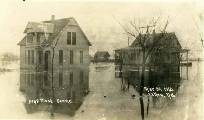Search the Blog
Categories
- Books & Reading
- Broadband Buzz
- Census
- Education & Training
- Friday Reads
- General
- Grants
- Information Resources
- Library Management
- Nebraska Center for the Book
- Nebraska Libraries on the Web
- Nebraska Memories
- Now hiring @ your library
- Preservation
- Pretty Sweet Tech
- Programming
- Public Library Boards of Trustees
- Public Relations
- Talking Book & Braille Service (TBBS)
- Technology
- Uncategorized
- What's Up Doc / Govdocs
- Youth Services
Archives
Subscribe
Author Archives: Beth Goble
Rising Waters
Today is the 100th anniversary of the March 30th, 1912 flood in Valley Nebraska. This year we are experiencing one of the warmest and driest months of March on record and drought is more to be feared than flooding. But last year was a different story – mountain snowpack and torrents of rain in Montana caused the Missouri River to flood. The Valley flood a century ago is another reminder that March is indeed a lion and a lamb. The winter of 1912 must have been much colder and longer than the one we have just experienced, because the large amount of ice still on the rivers formed ice jams and caused a very destructive flood.
Valley is located between the Platte and the Elkhorn rivers. The confluence of the two rivers is several miles south of the town. This excerpt from the Norfolk weekly News-Journal, March 29, 1912, Page 8 describes conditions at Valley on Tuesday, March 26.
“A. T. Hutchinson of the A. L. Kulian Co. , returned last night from Valley , Neb. , where he attended a directors meeting of a seed house of which he is a director. Mr. Hutchinson reports that much fear is entertained at Valley and Waterloo over the flood stage of the Platte river which is thirty feet high at the narrowed channel at the Burlington bridge at Fremont. The ice is thirty-six inches thick and a gorge is forming. Blasting has been going on for a week , but it is not believed that this will save the lowlands arount Valley from a flood. The Elkhorn river, says Mr. Hutchinson, is in good shape and he can see no danger of a flood in this vicinity.”
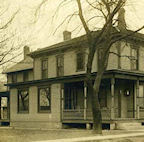 Valley Public Library has contributed a collection of photographs to Nebraska Memories depicting the town both before and after the flood. This 1910 photo of Reid’s Hotel at the corner of Front and Pine streets shows a substantial two-story building flanked by trees and paved sidewalks.
Valley Public Library has contributed a collection of photographs to Nebraska Memories depicting the town both before and after the flood. This 1910 photo of Reid’s Hotel at the corner of Front and Pine streets shows a substantial two-story building flanked by trees and paved sidewalks.
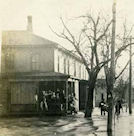 Two years later, this March 30, 1912 photo of the same corner shows that the flooding may have been even worse than Mr. Hutchinson’s comments to the newspaper suggested. Water is lapping at the foot of the front porch of the hotel and several people are standing on it surveying the flooded street. There must have been a lot of damage to the ground floor of the hotel and all the buildings on those streets. The photo description indicates that flood waters from the Platte and Elkhorn rivers merged and some areas were covered in four feet of muddy water.
Two years later, this March 30, 1912 photo of the same corner shows that the flooding may have been even worse than Mr. Hutchinson’s comments to the newspaper suggested. Water is lapping at the foot of the front porch of the hotel and several people are standing on it surveying the flooded street. There must have been a lot of damage to the ground floor of the hotel and all the buildings on those streets. The photo description indicates that flood waters from the Platte and Elkhorn rivers merged and some areas were covered in four feet of muddy water.
This photo taken in April 1912 shows damage to a wagon road near the railroad tracks. The road has eroded away and looks like a “gorge” such as Mr. Hutch inson told about. As the flood waters recede, undermined utility poles are falling over. The pole with the repair man perched on it looks like it could topple into the water at any moment–not a place I would have wanted to be! According to the photo description damages to the area were estimated at $40,000 – a hefty sum a century ago.
inson told about. As the flood waters recede, undermined utility poles are falling over. The pole with the repair man perched on it looks like it could topple into the water at any moment–not a place I would have wanted to be! According to the photo description damages to the area were estimated at $40,000 – a hefty sum a century ago.
And how would you like to be the poor people living in these homes? More photographs of the Valley flood of 1912 can be viewed in Nebraska Memories.
Visit Nebraska Memories to search for or browse through many more historical images digitized from photographs, negatives, postcards, maps, lantern slides, books and other materials.
Nebraska Memories is a cooperative project to digitize Nebraska-related historical and cultural heritage materials and make them available to researchers of all ages via the Internet. NebraskaMemories is brought to you by the Nebraska Library Commission. If your institution is interested in participating in Nebraska Memories, see http://nlc.nebraska.gov/nebraskamemories/participation.aspx for more information, or contact Beth Goble, Government Information Services Director, or Devra Dragos, Technology & Access Services Director.
The 1940 Census is Coming!
The Lincoln-Lancaster County Genealogical Society and Nebraska State Historical Society are sponsoring a special event to celebrate the the long-awaited release of the 1940 Census. It will be held Sunday, March 25, 2012 at 1:30 pm at Bess Dodson Walt Branch Library , 6701 South 14 th Street, Lincoln, NE.
The program is free, and will feature 1940 exhibits, music and memorabilia and a special presentation by Lori Cox-Paul, Director of Archival Operations, National Archives at Kansas City entitled “Introduction to the 1940 Census”.
The 1940 Census will be released digitally on April 2, 2012.
For more information about the celebration contact
jcook2@neb.rr.com
402-483-1239
Helping the Children
It’s nice when different projects we work on at the Library Commission come together in some way. In this case some biennial reports that we have scanned from our state documents collection are related to a new Nebraska Memories participant.
The Nebraska Children’s Home Society has a long history of caring for children who have been orphaned or become wards of the state. The Society recently contributed images of some of their historical photographs to Nebraska Memories. Dr. Elmer P. Quivey founded the Nebraska Children’s Home Society in 1893 and was the State Superintendent from 1893 to 1920. The Society offered support and assistance to parents committed to keeping their family together, and provided foster and adoptive homes for children who could not stay with their families. It also worked to find homes for children admitted to the state Home for the Friendless. The 1904 Biennial Report of the Home for the Friendless provides a wealth of information about the education, nutrition, health and placement of children who lived there.
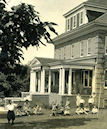 In 1923 the Nebraska Children’s Home Society constructed a building at 3549 Fontenelle Boulevard in Omaha. It was a residence for children awaiting adoption as well as the Society headquarters. In this photo a badminton game is being played on the lawn by two boys, while other children watch. I love the bloomer style pants one of the players is wearing! Additions were made to the building in 1948 and 1965.
In 1923 the Nebraska Children’s Home Society constructed a building at 3549 Fontenelle Boulevard in Omaha. It was a residence for children awaiting adoption as well as the Society headquarters. In this photo a badminton game is being played on the lawn by two boys, while other children watch. I love the bloomer style pants one of the players is wearing! Additions were made to the building in 1948 and 1965.

 These fellows are obviously having a great time as toymakers in training. Were the toys being made for younger children at the home, for them to play with, or perhaps to sell to support the Home? They were gaining skills in the shop that would have been helpful for future employment.
These fellows are obviously having a great time as toymakers in training. Were the toys being made for younger children at the home, for them to play with, or perhaps to sell to support the Home? They were gaining skills in the shop that would have been helpful for future employment.
 These girls were gaining other skills – in the domestic arts – while baking a cake. Do you think the boys ever got to help with the cooking or the girls ever got to work in the shop?
These girls were gaining other skills – in the domestic arts – while baking a cake. Do you think the boys ever got to help with the cooking or the girls ever got to work in the shop?
Visit Nebraska Memories to search for or browse through many more historical images digitized from photographs, negatives, postcards, maps, lantern slides, books and other materials.
Nebraska Memories is a cooperative project to digitize Nebraska-related historical and cultural heritage materials and make them available to researchers of all ages via the Internet. Nebraska Memories is brought to you by the Nebraska Library Commission. If your institution is interested in participating in Nebraska Memories, see http://nlc.nebraska.gov/nebraskamemories/participation.aspx for more information, or contact Beth Goble, Government Information Services Director, or Devra Dragos, Technology & Access Services Director.
Posted in General, Nebraska Memories
Leave a comment
We Really are Living Longer
You may have seen recent news reports about the drop in fatal automobile accidents in Nebraska to the lowest level since 1944. Other causes of death, including homicide, have dropped too. The latest mortality report from the National Center for Health Statistics, Deaths, Preliminary Data for 2010 provides a wealth of information about what we are dying of and how long we live. Life expectancy increased from 78.6 in 2009 to 78.7 in 2010. Interestingly, Hispanics live the longest (83.8 years for females, 78.8 for males). The CDC/NCHS site is a wonderful source of informaton that even has a for librarians section. The leading causes of death are
Diseases of the heart
Malignant neoplasms
Chronic lower respiratory diseases
Cerebrovascular diseases
Accidents (unintentional injuries)
Alzheimer’s disease
Diabetes mellitus
Looking at this list reminds me that although death comes to all of us, lifestyle can affect the length and quality of life. I’m planning to eat more fish, exercise more, and buckle up every time I get into the car.
Digital Encyclopedia of the Great Plains is Online
The University of Nebraska-Lincoln has launched an incredible resource online: the Digital Encyclopedia of the Great Plains. We have it linked from this part of our NebraskAccess website.
With 1,316 entries contributed by more than one thousand scholars, this groundbreaking reference work captures what is vital and interesting about the Great Plains—from its temperamental climate to its images and icons, its historical character, its folklore, and its politics.
The Great Plains is a vast expanse of glasslands stretching from the Rocky Mountains to the Missouri River and from the Rio Grande to the coniferous forests of Canada—an area more than eighteen hundred miles from north to south and more than five hundred miles from east to west. The Great Plains region includes all or parts of Texas, New Mexico, Oklahoma, Kansas, Colorado, Nebraska, Wyoming, South Dakota, North Dakota, Montana, Alberta, Saskatchewan, and Manitoba. The region, once labeled “the Great American Desert,” is now more often called the “heartland,” or, sometimes, “the breadbasket of the world.” Its immense distances, flowing grasslands, sparse population, enveloping horizons, and dominating sky convey a sense of expansiveness, even emptiness or loneliness, a reaction to too much space and one’s own meager presence in it.
The Plains region is the home of the Dust Bowl, the massacre at Wounded Knee, the North-West Rebellion, the Tulsa race riot, the Lincoln County War, the purported Roswell alien landing, and the Sturgis Motorcycle Rally. Its products have included furs, cattle, corn, wheat, oil, gas, and coal as well as jazz, literature, and political reform. It has been inhabited for more than twelve thousand years, since Paleo-Indians hunted mammoth and bison. More recent emigrants came from eastern North America, Europe, Latin America, and Asia, resulting in a complex and distinctive ethnic mosaic.
Posted in General, Information Resources
Leave a comment
The Weather Outside is Frightful
Oh the weather outside is frightful,
But the fire is so delightful,
And since we’ve no place to go,
Let It Snow! Let It Snow! Let It Snow!
I love this song, created by lyricist Sammy Cahn and composer Jule Styne in 1945. Today is the official first day of winter, but we know that in Nebraska snow usually arrives earlier at least somewhere in the state. The song is about staying inside while it snows, but we have lots of examples in Nebraska Memories of people being OUTSIDE to play or work in the snow. 
This 1940 image of Children and adults by a truck shows 13 kids packed into the back of a truck for a ride sponsored by the Dundee Kiwanis Club. The four women are dressed in the long coats and skirts typical of that era, plus a lone gentleman who was probably the driver. No seatbelts in those days!
The Dundee Kiwanis Club also flooded part of their playground in the winter to make an outdoor rink for ice skating . I fondly remember the outdoor rink at my neighborhood community league playground in Edmonton, Alberta, where I grew up. The boys played hockey and the girls took figure skating lessons. How times have changed – now girls get to play hockey too!
 Adults also liked to have fun in the snow, like this group of students having a snowball fight at Union College in the first decade of the 20th century. Do you wonder if the young man dropping the snowball on the head of the young woman next to him was trying to get her attention for other reasons?
Adults also liked to have fun in the snow, like this group of students having a snowball fight at Union College in the first decade of the 20th century. Do you wonder if the young man dropping the snowball on the head of the young woman next to him was trying to get her attention for other reasons?
But work has to be done no matter what the weather is like . Livestock still needs feeding and somebody has to keep the wheels turning, like Engineer G. Strayer driving a train through snow following a blizzard in southwest Nebraska in the late 1940’s.
Visit Nebraska Memories to search for or browse through many more historical images digitized from photographs, negatives, postcards, maps, lantern slides, books and other materials.
Nebraska Memories is a cooperative project to digitize Nebraska-related historical and cultural heritage materials and make them available to researchers of all ages via the Internet. Nebraska Memories is brought to you by the Nebraska Library Commission. If your institution is interested in participating in Nebraska Memories, see http://nlc.nebraska.gov/nebraskamemories/participation.aspx for more information, or contact Beth Goble, Government Information Services Director, or Devra Dragos, Technology & Access Services Director.
Posted in General, Information Resources, Nebraska Memories
Leave a comment
Filling out Form I-9
At the NLC reference desk we get chats, emails and calls fairly often from businesses looking for online copies of Form I-9, Employment Eligibility Verification.
Since 1986 Congress has passed three acts relating to illegal immigration, resulting in requirements that employers only hire individuals who may legally work in the U.S. To comply with the law employers must verify the identity and employment authorization of everyone they hire, complete and retain a Form I-9, and refrain from discriminating against individuals on the basis of national origin or citizenship. There are sanctions for employers who do not comply. Needless to say this is a challenge, and U.S. Citizenship and Immigration Services has created a 66-page Handbook for Employers . The Handbook includes detailed intructions for filling out the form and for photocopying and retaining forms and supporting documentation. Information on penalties for unlawful descrimination, instructions for farm labor recruiters, and a Question & Answer section are also included. Another section explains using E-Verify, the web-based verification companion to Form I-9. Employers must create a “case” in E-Verify for each new hire.
Downloadable English and Spanish versions of Form I-9 and the Handbook for Employers are available on the USCIS website . Print forms and Handbooks can be requested by calling 1-800-870-3676. The Library Commission has a print copy of the Handbook available for loan by contacting us at nlc.ask@nebraska.gov or calling 800-307-2665 (Nebraska only) or 402-471-4016.
Celebrating Native American Heritage
 November is Native American Heritage Month, and this week we are highlighting a collection of photographs taken by John Alvin Anderson . The images were contributed to Nebraska Memories by the Nebraska State Historical Society, which scanned part of its collection of Anderson’s glass plate negatives. John A. Anderson was born in Sweden in 1869 and brought to Pennsylvania with his family in 1870. In 1883 he came to Cherry County with his father and brothers. He learned photography at an early age and took photographs of soldiers and natives living at Fort Niobrara and the Rosebud Reservation in South Dakota. In 1889 he was the official photographer for the Crook Treaty Council held by General George Crook with the Brule Sioux at the Rosebud Reservation.
November is Native American Heritage Month, and this week we are highlighting a collection of photographs taken by John Alvin Anderson . The images were contributed to Nebraska Memories by the Nebraska State Historical Society, which scanned part of its collection of Anderson’s glass plate negatives. John A. Anderson was born in Sweden in 1869 and brought to Pennsylvania with his family in 1870. In 1883 he came to Cherry County with his father and brothers. He learned photography at an early age and took photographs of soldiers and natives living at Fort Niobrara and the Rosebud Reservation in South Dakota. In 1889 he was the official photographer for the Crook Treaty Council held by General George Crook with the Brule Sioux at the Rosebud Reservation.

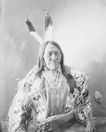 In 1895 Anderson married and moved to the Reservation with his wife, where he opened a store and continued to photograph the people living there. He was able to photograph several chiefs, including this 1902 one of Chief Two Strike , who was a member of a delegation to Washington, D.C. after the Wounded Knee Massacre in 1890. He also took many photos of daily activities like cattle branding and butchering and of festivities like the Grass Dance pictured at the top of this posting, which is still danced today .
In 1895 Anderson married and moved to the Reservation with his wife, where he opened a store and continued to photograph the people living there. He was able to photograph several chiefs, including this 1902 one of Chief Two Strike , who was a member of a delegation to Washington, D.C. after the Wounded Knee Massacre in 1890. He also took many photos of daily activities like cattle branding and butchering and of festivities like the Grass Dance pictured at the top of this posting, which is still danced today .
Setting aside a time to honor Native Americans has been advocated for many years, and some states have done this. Although an official national holiday has never been enacted, in 1990 Congress passed a resolution designating November as National American Indian Heritage Month. The designation has been renewed each year since 1994. The Library of Congress, National Archives and Records Administration, National Endowment for the Humanities, National Gallery of Art, National Park Service, Smithsonian Institution and United States Holocaust Memorial Museum host the Native American Heritage Month website linking to collections, images, audio, video and teacher guides documenting native history and traditions.
Visit Nebraska Memories to search for or browse through many more historical images digitized from photographs, negatives, postcards, maps, lantern slides, books and other materials. Nebraska Memories is a cooperative project to digitize Nebraska-related historical and cultural heritage materials and make them available to researchers of all ages via the Internet. Nebraska Memories is brought to you by the Nebraska Library Commission. If your institution is interested in participating in Nebraska Memories, see http://nlc.nebraska.gov/nebraskamemories/participation.aspx for more information, or contact Beth Goble, Government Information Services Director, or Devra Dragos, Technology & Access Services Director.
More about Voter Education Materials from LWVNE
The League of Women Voters of Nebraska (LWVNE) has been “happily overwhelmed” with orders for voter information materials since libraries and media centers were emailed about them last Friday. All orders placed prior to October 26, 2011, will be filled as soon as possible as promised. You may continue to place orders and the League will fill them to the extent materials are still available. Scanned images of both the VOTE brochure and the Voting Rights brochure have also been added to the LWVNE Web site for you to download for your use. If you have any questions about your order or the materials, please contact the League at 402-475-1411.
http://lwv-ne.org/files/vote-brochure-1-4.pdf
http://lwv-ne.org/files/vote-brochure-5-7.pdf
http://lwv-ne.org/files/vote-brochure-upper-outside.pdf
http://lwv-ne.org/files/vote-brochure-lower-outside.pdf
http://lwv-ne.org/files/voting-rights-brochure-inside.pdf
http://lwv-ne.org/files/voting-rights-brochure-outside.pdf
Special Session about the Pipeline
Governor Dave Heineman announced today that he will call a special legislative session of the Nebraska Legislature to consider legislation regarding the proposed Keystone XL pipeline. The session will begin Nov. 1. Presumably floor debates will be streamed by Nebraska Educational Telecommunications. Watch the Legislature’s session information website for updates. http://nebraskalegislature.gov/session/session_info.php .
Free voter education materials for libraries
The League of Women Voters of Nebraska (LWVNE) has free voter brochures and DVDs that libraries can request to share with their patrons. This form can be used to order by mail or by emailing the LWVNE office. The form can also be copied and provided to other organizations within your community who would like to distribute the materials.
Vote: Your Voice Your Future is a pocket-sized folding brochure explaining
how to register, get educated about issues, and vote by mail or in person.
Voting Rights of Nebraskans explains voting rights.
Voices of Voters is a 10-minute film featuring Nebraskans (young, old, new citizen,
ex-felon) overcoming barriers to voting.
Morning Edition is a humorous 5- minute you-tube video depicting a tousled student being pestered to vote by an unusual source.
Orders are filled on a first-received, first-processed basis, so it is best to order as far as
in advance of the required receipt date as possible. If you have questions about the materials, please contact LWVNE at 402-475-1411 or email lwv-ne@inebraska.com.
Visit the LWVNE website http://lwv-ne.org to preview both videos.
Tell it to the Judge
We had an interesting situation at the Library Commission this month when two of our staff members were called to serve on a jury the same week as the NLA/NEMA library conference. One ended before it began (mistrial) and the other only lasted a few days. I served on a jury years ago and actually enjoyed the experience. Despite the temporary interruption of my normal activities, I found it fascinating – jury selection, attorney questioning to “winnow” the jury pool, testimony, deliberation, and a visit from the judge after it was over to tell us he thought we “got it right” (whew!). Pondering these legal affairs got me wondering what images relating to trials and courts we have in Nebraska Memories.
Several participants have contributed photos of county or federal courthouses, sometimes several buildings over a span of years. They were important centers of government, and are still the primary government buildings in many Nebraska communities. Some had very modest beginnings.
The first Cheyenne County Courthouse
was originally Suttler’s Store at Fort Sidney. 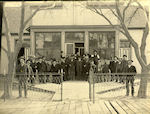
The front porch was a convenient place
for local dignitaries to gather and have their picture taken.
 The next courthouse was a much grander affair that also served as a backdrop for this famous Nebraska politician to be photographed while on the stump. It remained standing until a new courthouse was built around it in 1968.
The next courthouse was a much grander affair that also served as a backdrop for this famous Nebraska politician to be photographed while on the stump. It remained standing until a new courthouse was built around it in 1968.
Some cases go all the way to the top. This photo from the Townsend Studio collection shows the seven men serving as Nebraska Supreme Court Judges in 1921. The first female Supreme Court judge, Lindsey Miller-Lerman, was appointed in 2006. Photos of the current Supreme Court chambers and justices can be viewed on the Nebraska Judicial Branch website.
 More images of Nebraska courthouses can be viewed here.
More images of Nebraska courthouses can be viewed here.
Visit Nebraska Memories to search for or browse through many more historical images digitized from photographs, negatives, postcards, maps, lantern slides, books and other materials. Nebraska Memories is a cooperative project to digitize Nebraska-related historical and cultural heritage materials and make them available to researchers of all ages via the Internet. Nebraska Memories is brought to you by the Nebraska Library Commission. If your institution is interested in participating in Nebraska Memories, see http://nlc.nebraska.gov/nebraskamemories/participation.aspx for more information, or contact Beth Goble, Government Information Services Director, or Devra Dragos, Technology & Access Services Director.
Posted in General, Nebraska Memories, Technology
Leave a comment
Groundwater and the Pipeline
With all the controversy about the Keystone XL pipeline swirling in the state, people following the debate may be interested in these state and federal documents available online.
The 1986 edition of the Groundwater Atlas of Nebraska has been added to the state epubs collection. The atlas, published by the UNL Conservation and Survey Division (now part of the School of Natural Resources) features maps and narrative showing groundwater reservoirs, rock formations, transmissivity, depth to water, dissolved solids, irrigation, etc.
And of course the final environmental impact statement on the pipeline is available on the U.S. Department of State website. At a daunting 8 volumes it is not for the faint of heart, but a 27-page executive summary is also available.
Those Magnificent Flying Machines
On September 20, 1904, Wilbur Wright flew the first complete circle in history by a manned heavier-than-air powered machine, flying the Wright brothers’ biplane 4,080 feet. It wasn’t a quick circle, taking about a minute and a half. This image from the Library of Congress American Memory Collection of a page from Wilbur’s logbook shows data and a diagram of the flight.
It wasn’t long before Nebraskans were soaring in those flying machines. Dr. Frank A. Brewster  of Beaver City was known as the Flying Doctor. Dr. Brewster embraced new tools to help him with his far-flung practice in western Nebraska and Kansas. He began using a motorcycle in 1903 to make his rounds, and in 1905 got an automobile. In 1919 he bought a biplane and hired World War I pilot Wade Stevens to fly him to his patients. The duo is pictured on the left with the plane. On May 23rd 1919 he flew to Herndon Kansas to perform surgery on an oilfield worker who had suffered a crushed skull in an accident – possibly the first time an airplane was used for commercial or humanitarian purposes. Dr. Brewster continued his flying practice until 1937 and learned to fly himself in 1943, at the age of 71. More images in Nebraska Memories of Dr. Brewster can be viewed here.
of Beaver City was known as the Flying Doctor. Dr. Brewster embraced new tools to help him with his far-flung practice in western Nebraska and Kansas. He began using a motorcycle in 1903 to make his rounds, and in 1905 got an automobile. In 1919 he bought a biplane and hired World War I pilot Wade Stevens to fly him to his patients. The duo is pictured on the left with the plane. On May 23rd 1919 he flew to Herndon Kansas to perform surgery on an oilfield worker who had suffered a crushed skull in an accident – possibly the first time an airplane was used for commercial or humanitarian purposes. Dr. Brewster continued his flying practice until 1937 and learned to fly himself in 1943, at the age of 71. More images in Nebraska Memories of Dr. Brewster can be viewed here.
Air shows in the pioneering days of flight were popular events showcasing flying machines and the skill of the pilots, just as they are today. Aerial performances are dangerous and can be fatal. This summer the pilot was killed at a crash at the Kansas City Air Show in August and there are multiple deaths (11 at this writing) from the crash this month at the Reno Air Race.
We don’t know if the pilot of the plane which crashed on the roof of a barn at an early Nebraska air show survived, but the plane certainly didn’t.  More images of biplanes in Nebraska Memories can be viewed here .
More images of biplanes in Nebraska Memories can be viewed here .
Visit Nebraska Memories to search for or browse through many more historical images digitized from photographs, negatives, postcards, maps, lantern slides, books and other materials.
Nebraska Memories is a cooperative project to digitize Nebraska-related historical and cultural heritage materials and make them available to researchers of all ages via the Internet. Nebraska Memories is brought to you by the Nebraska Library Commission. If your institution is interested in participating in Nebraska Memories, see http://nlc.nebraska.gov/nebraskamemories/participation.aspx for more
information, or contact Beth Goble, Government Information Services Director,
or Devra Dragos, Technology & Access Services Director.
Help Preserving Your Collections
Nebraska has many museums and libraries with great historical collections. Getting help to preserve those collections is a big challenge, especially for small organizations. Connecting to Collections Online Community is a new free interactive resource to connect staff at small museums, archives, and libraries with each other and top-flight information about collections care. Visit the site and register (free) to access features such as:
Meeting Room hosting free Webinars with leading conservation professionals
Discussion Forum where online community members can post questions
Calendar of events, online training opportunities, and grant deadlines
Topics Archive of past C2C Online Community discussions and presentations
The Online Community has a Facebook page http://www.facebook.com/C2Ccommunity
The Community is based on the initiative begun by the Institute of Museum and Library Service (IMLS) called Connecting to Collections. The initiative has included grant programs, national forums, workshops, a bookshelf distribution, and webinars.
Family History Fair
If you are interested in family history and you live in the Lincoln area, here’s an opportunity to find out about some resources that can help. The Lincoln-Lancaster County Genealogical Society is sponsoring a Family History Fair.
Sunday October 2, 2011 2:00-4:00 p.m.
Heritage Hall, lower level of the College View Adventist church.
48th & Prescott Streets, Lincoln, NE
The event is free and open to the public. Phyllis Ericson, President of the LLCGS, will welcome attendees and give a talk entitled “Honoring Your Ancestors”. From 2:30 – 4:00 attendees will be able to visit the exhibit area, sample ethnic food, and learn about genealogy help, resources & libraries, family collections, publishing your family history, technology, and fall genealogoy classes. The Library Commission will be in the exhibit area to provide information about two resources that we provide:
Nebraska Memories , our project to digitize Nebraska-related historical and cultural heritage materials.
HeritageQuest Online , a family history database made available at no cost to all Nebraskans via NebraskAccess.
Researching my family history is on my bucket list–how about you?
Posted in Uncategorized
Leave a comment
Can the Statistical Abstract be Saved?
When I attended the annual Nebraska State Data Center Conference at UNO last week we were given a DVD copy of the 2011 Statistical Abstract of the United States, with the comment that it’s a $150 value and the 2012 edition will be the last one produced.
Robert Samuelson pleads “don’t kill America’s data book” in his column in the August 21 Washington Post. Samuelson notes that the Census Bureau’s 2012 budget would eliminate the Statistical Compendia Branch, which produces the Statistical Abstract, County and City Data Book, and other publications. The cut would eliminate 24 jobs and save $2.9 million dollars. Samuelson suggests that the Census Bureau could seek a private funder for the Abstract like the Gates or McArthur foundations.
I’m not optomistic.
Dog Days
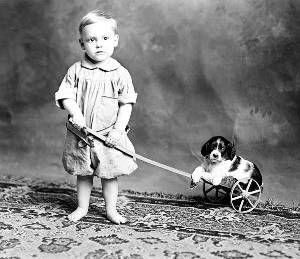 We Nebraskans are used to suffering through blisteringly hot days in late summer, and we sometimes refer to them as the Dog Days. The phrase comes from the Roman calendar, which referred to the period spanning July 24 to August 24 as diēs caniculārēs, associated with the star Sirius. Sirius is called the Dog Star, and is the brightest star in the constellation Canis Major.
We Nebraskans are used to suffering through blisteringly hot days in late summer, and we sometimes refer to them as the Dog Days. The phrase comes from the Roman calendar, which referred to the period spanning July 24 to August 24 as diēs caniculārēs, associated with the star Sirius. Sirius is called the Dog Star, and is the brightest star in the constellation Canis Major.
Another definition from Wikipedia seems ironic considering the anything-but-slow performance of the stock market this summer: In recent years, the phrase “Dog Days” or “Dog Days of Summer” have also found new meanings. The term has frequently been used in reference to the American stock market. Typically, summer is a very slow time for the stock market, and additionally, poorly performing stocks with little future potential are frequently known as “dogs”.
While we may not always associate hot weather with constellations, finance or dogs, the waning days of summer do seem like a good time to celebrate our canine companions. A search in Nebraska Memories brings up a wealth of images of dogs in their various roles. The pampered household pet in the image above must have been the darling of it’s family. 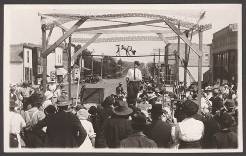
Others were working dogs pulling travois for their native masters or herding cattle for their rancher owners. Still others were entertainers like the dog walking on the tight rope depicted here. I hope it wasn’t too scared doing the high wire act! Or they may simply have been overheated pooches getting into the shade like this one in front of Blondy’s Barber Shop and Pool Hall in Brainard.
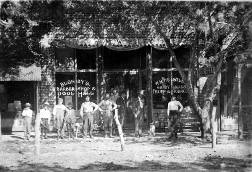 Visit Nebraska Memories to search for or browse through many more historical images digitized from photographs, negatives, postcards, maps, lantern slides, books and other materials.
Visit Nebraska Memories to search for or browse through many more historical images digitized from photographs, negatives, postcards, maps, lantern slides, books and other materials.
Nebraska Memories is a cooperative project to digitize Nebraska-related historical and cultural heritage materials and make them available to researchers of all ages via the Internet. Nebraska Memories is brought to you by the Nebraska Library Commission. If your institution is interested in participating in Nebraska Memories, see
<http://nlc.nebraska.gov/nebraskamemories> for more information, or contact Beth Goble, Government Information Services Director, or Devra Dragos ,Technology & Access Services Director.
Free Collection Preservation Webinars from National Parks Service
Heritage Preservation is pleased to announce a special partnership with the National Park Service to bring the advice of their best experts to collecting institutions nationwide.
Identifying Museum Insect Pest Damage and Addressing it with Integrated Pest Management
Wednesday, July 20 at 3:00 pm EDT
Led by Barbara Cumberland, Conservator, Museum Conservation Services at the Harpers Ferry Center, National Park Service, and Carol DiSalvo, Integrated Pest Management Coordinator at the National Park Service. Click here to view the featured resources we will be discussing on this webinar.
_______________________________________________________________________________________________
Cold Storage for Photographic Materials
Tuesday, August 2 at 2:00 pm EDT
Theresa Anne Voellinger, Paper/Photograph Conservator, Harpers Ferry Center, National Park Service will join us to discuss the Connecting to Collections Online Community’s Featured Resource for August – the online video series Cold Storage: A Long-Term Preservation Strategy for Film-Based Photographic Materials.
To join us at these events, go to http://www.connectingtocollections.org/ and click “Access Meeting Room”. We look forward to meeting you online!
Posted in General, Library Management
Leave a comment
Nebraska Blue Book 2010-2011 available
The 2010-2011 Nebraska Blue Book has been published. Each public, academic and state institutional library in Nebraska will be receiving a free copy. It is also available online at http://nebraskalegislature.gov/about/blue-book.php .
The Blue Book is Nebraska’s official reference manual, and is a gold mine of information about the state’s government, geography, economy, history and culture.
Bound, printed copies of the 2010-11 Nebraska Blue Book are available for purchase through the Clerk of the Legislature’s Office and may be ordered by calling (402) 471-2271. The cost is $15 plus postage and sales tax as applicable.
